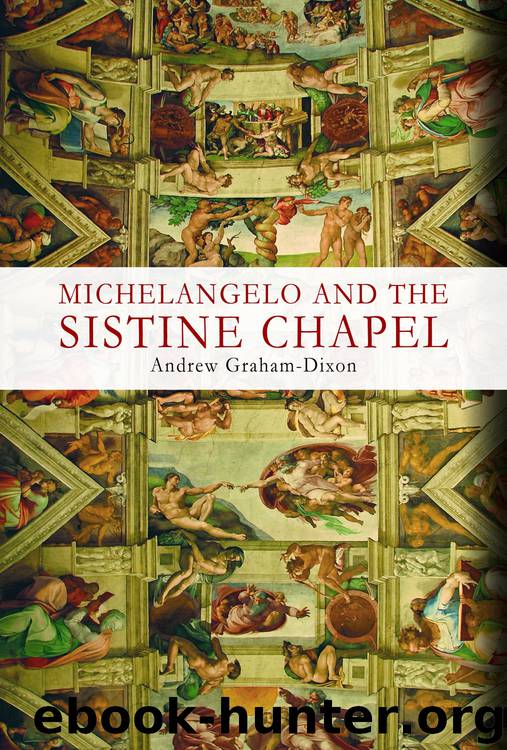Michelangelo And The Sistine Chapel by Andrew Graham-Dixon

Author:Andrew Graham-Dixon
Language: eng
Format: epub
Publisher: Skyhorse Publishing, Inc.
Published: 2011-02-01T16:00:00+00:00
The Deluge is flanked by two other paintings representing scenes from the biblical story of Noah. The first of these, which can be identified as The Sacrifice of Noah, appears to be the only one of the Sistine ceiling’s narrative pictures to have been placed out of chronological sequence. It precedes The Deluge, although logic dictates that it should come afterwards, given that its subject is Noah’s sacrifice to God for having spared him and his family from the Flood. The subject is described in Genesis 8: 20-1: ‘And Noah builded an altar unto the Lord; and took of every clean beast, and of every clean fowl, and offered burnt offerings on the altar. And the Lord smelled a sweet savour; and the Lord said in his heart, I will not again curse the ground any more for man’s sake; for the imagination of man’s heart is evil from his youth; neither will I again smite any more everything living, as I have done.’
Michelangelo’s decision to place this scene first has been the cause of some confusion. The artist’s early biographers, Giorgio Vasari and Ascanio Condivi, assumed that the picture did not illustrate the life of Noah at all, but must represent the sacrifice of Cain and Abel. Their explanation, which has been followed by some modern scholars, has the virtue of restoring chronological integrity to Michelangelo’s fresco cycle (since Cain and Abel’s sacrifice occurs well before the Flood in the Book of Genesis). But it is contradicted by the visual evidence of the fresco itself. There are no obvious candidates for the figures of Cain and Abel, while Abel’s offering, ‘the fruit of the ground’ (Genesis 4: 3), is nowhere to be seen. The congested queue of animals awaiting sacrifice, which include an elephant, is surely intended to suggest the multitude of living creatures disgorged from the Ark.
Comparison with the other frescoes definitively confirms the subject as The Sacrifice of Noah. The patriarch may only appear as a diminutive figure in The Deluge, but his principal attributes are unmistakable. He wears red, and he has a long white beard. So too does the figure at the centre of Michelangelo’s scene of sacrifice. The altar over which he presides stands next to a structure resembling part of the Ark in The Deluge. There is further supporting evidence, if any were needed, in the distinct similarity between Noah’s three sons in the nearby Drunkenness of Noah and three of the youths assisting at the rite in The Sacrifice – the boy bearing logs for the fire, the boy kneeling astride the dead ram, and the boy peering into the altar flames. They are the same figures in different poses.
So the chronological conundrum remains, but Michelangelo’s apparently puzzling decision to place the scene out of sequence is most plausibly explained as a victory for expressive power over strict narrative coherence. The Deluge, a subject that involved multitudes fleeing a rising flood, clearly called out for the largest of the three fields dictated by the structure of the ceiling’s design.
Download
This site does not store any files on its server. We only index and link to content provided by other sites. Please contact the content providers to delete copyright contents if any and email us, we'll remove relevant links or contents immediately.
Michelangelo And The Sistine Chapel by Andrew Graham-Dixon(1026)
Seven Secrets of Shiva by Devdutt Pattanaik(930)
Accounts and Images of Six Kannon in Japan by Sherry D. Fowler(925)
The Geometry of Love by Margaret Visser(921)
Saints, Shrines and Pilgrims by Roger Rosewell(895)
The Mushroom in Christian Art by John A. Rush(888)
Resurrecting Easter by John Dominic Crossan(872)
The Lost Painting by Jonathan Harr(868)
Buddhism Illuminated by San San May Jana Igunma(855)
THE FRESCO by The Fresco(852)
Ayala's Angel by Anthony Trollope(820)
Illuminated Manuscripts by Richard Hayman(820)
The Handbook of Tibetan Buddhist Symbols by Robert Beer(795)
Creating Personal Mandalas by Cassia Cogger(789)
Silence and Beauty by Makoto Fujimura(772)
Moon by the Window by Shodo Harada(746)
Dharma Delight by Rodney Alan Greenblat(734)
Saint Paul by Pier Paolo Pasolini(733)
Art From The Sacred To The Profane: East by Schuon Frithjof(732)
